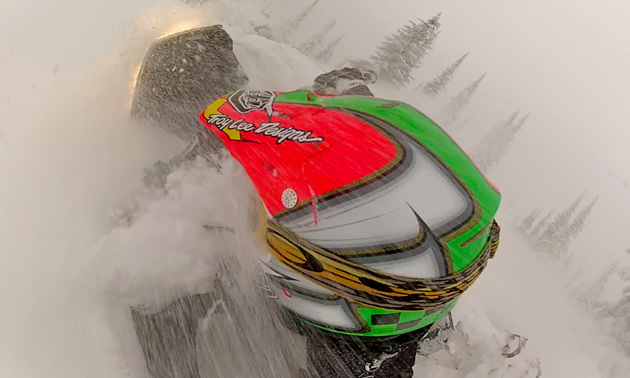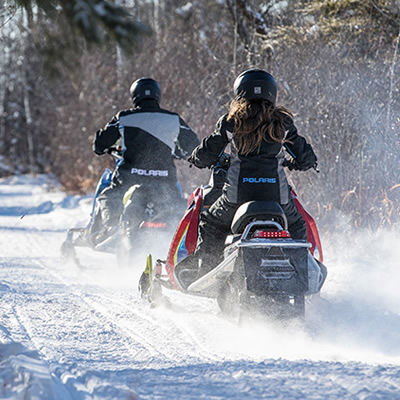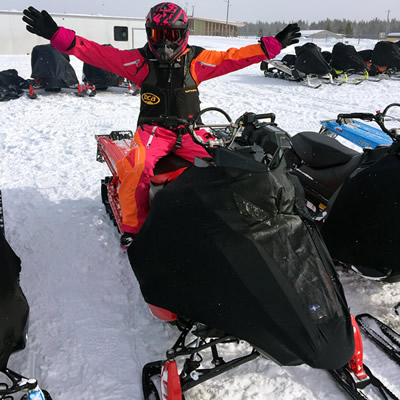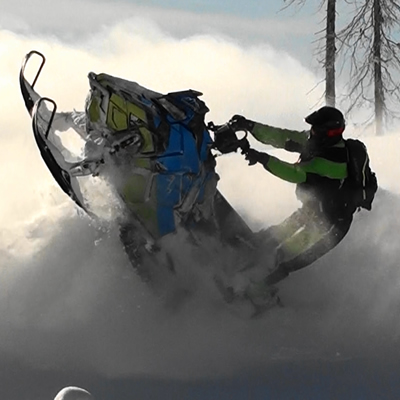ATV, snowmobile and dirt bike injuries are a common occurrence. Quite often, when we think of accidental injuries relating to powersports, a vision of the inexperienced rider (the newbie) comes to mind—those who simply “didn’t know any better.” Is this the reality of common injuries? A matching set of scars on my calf muscles tell the tale of my lapse in judgement: wearing improper clothing—not once, but twice—which caused my bare skin to become too acquainted with a hot ATV exhaust pipe. I can still smell the odour of my melting skin that hot summer day. In retrospect, I had appropriate pants and boots but shorts and thongs were my foolish choice of clothing. I knew better.
I have to share something ironic. My 14-year-old son, Leo, is brilliant—most of the time. I asked him to proofread this article and we discussed my scars from hot pipes. About three hours after he read this article, he showed me a burn on his thigh, which was from his bike. Yes, I know, we both shook our heads. Welcome to the world of learning, my little bud.
Here’s a message to all of our “inner cocky,” a gentle reminder that none of us are more talented than accident and injury. We’ve got the gear so we need to wear it and use it wisely.
Kneepads—your best friend
Sledders often say that injuries to their knees are one of the most avoidable injuries of all. The knees and shins quite often fall prey to the aggressive design of modern-day snowmobile running boards, which are designed with sharp grips to provide rider traction. The solution? A pair of $30 knee/shin pads.
I can attest to this. My running boards have bitten me more than once—until my husband gave me a pair of Fox knee/shin pads for Christmas. I even wore them the day of our wedding, which was a sledding wedding up the Salmo-Creston Pass in the Selkirk Mountains of B.C. If anyone lacks as much grace as I do when it comes to landing jumps, kneepads will be your best friend. Or, if you unintentionally smoke trees at a high rate of speed, I can confirm, without a doubt, your knees will be one of the first things to impact your sled. Ahh, good times.
Shield your eyes
Sunglasses are not necessarily a safe alternative to protective eyewear. Dust particles, sticks and damaging UV rays can all permanently damage your eyes.
Choose your eyewear carefully. Some light conditions can be extremely dangerous. Flat light haunts all snowmobilers from time to time. Flat light is a term used to describe low visibility combined with low definition—making it very difficult to see changes in terrain, such as dips, creek beds and drops. Many unsuspecting riders find their snowmobiles abruptly stopping, while they crash into or propel over their handlebars. Visibility can be improved by choosing the appropriate goggle lens for your specific light condition. Yellow and blue lenses can help improve terrain definition in flat light. Quite often, sledders choose their style of goggles based upon what is cool, hip and fly—all fine and dandy, but sometimes you just have to put away those ultra-sexy, mirrored lenses and utilize the old faithful yellow lens to save your entire skeletal structure from sheer agony. Try out a variety of lenses to see what colour best suits your particular eyesight. Usually yellow, blue and rose are the high-visibility lenses of choice.
Wear your lid
Meh, I’m just going around the corner, I don’t need my helmet. There’s lots of tales of helmet-free riders who were just scooting a short distance on their ATVs and bikes and ended up in disaster as they rolled, crashed and burned without a helmet. Travelling from campsite to campsite, or moving bales—the old-school, helmetless mentality contributes to reports of death and disaster.
Broken jaws, concussions and more serious head injuries are usually the end result. My neighbour’s three weeks in intensive care after a harmless huckleberry-picking trip up the road confirms the importance of a helmet.
Accidents are never planned, but some can be avoided. Always wear your lid. End of story.
Glove up
Wear the proper gloves for riding and wrenching. It is a known fact, when we start to fall, the first impact will be to our hands as we reach out in front of us to cushion the blow. Many motocross-style gloves come with extra padding to shield your fingers from injury. Leather is specifically used for its thick protective characteristics to prevent abrasion.
Wrenchers constantly bang their knuckles while working on their rides. Mechanic-style gloves are designed to take some of that impact and protect your hands. It just may save your fingers from arthritis in the long run.
On a related note, you may love your husband or wife to the ends of the earth but take off your rings when riding and wrenching. One wrong move and your finger will be no more as it becomes snagged on one of the many dangerous locations on your unit.
Core safety
I doubt there is anyone out there who plans on experiencing a broken rib or punctured lung or spleen when they go out riding. Without chest protection, you leave yourself vulnerable to all of the above. When I broke my ribs it was a harmless rollover on a tame logging road that caused my handlebar to jab painfully into my ribs. Laying there pinned under my machine, I thought to myself, “Hmm, I should be wearing chest protection right now.” Good plan.
Tek vests and chest protectors work. You get used to them quickly so don’t let the initial feeling of discomfort deter you from wearing appropriate chest protection.
Wear avalanche gear
I know it should go without saying, but I’ll say it anyway. Never take avalanche safety for granted. Have the gear, and use it always—even when you think an area is low risk or safe. Always wear your beacon, shovel and probe and know how to use them. Never let your beacon battery strength drop below 90 per cent, and practise routine beacon checks before you begin your journey. The consequences are huge if you don’t. I have invested in an avalanche pack, which I believe further increases my ability to survive—in the event an avalanche. Never ever let your safety equipment create a false sense of security when you are out snowmobiling.
Education is an absolute must and it is available to all sledders. Know before you go, plain and simple. I am thankful that this past season saw a decrease in the number of snowmobiler deaths. We need to keep up the momentum and not rely on tragedy to spark awareness.
Watch the winch
Winches are a popular accessory on many ATVs and UTVs. They can make life easier in situations where the unit is stuck in mud or snow, and will help pull the unit to freedom. Many people take winch safety for granted. Here are a few winch tips to keep us all on our toes.
Always wear leather gloves when using your winch—fingers can get pinched and squished quickly. Never wrap the winch around your hands. If the winch line were to snap, it could cause a recoil effect and pull your hand towards the winch causing severe injury. Have respect for your winch line. Conventional steel wire winch line stores energy in its cable and if that cable snaps, innocent bystanders could fall victim to its powerful blow.
There are several reports of people injured while using their winch to lift up the unit so it can be worked on. This is not a good idea. Stories of people getting injured and crushed under their units when their winch cable snapped are plentiful. Use a proper hoist when working on your units.
Harmless fun?
Just jackin’ around—I posted this topic up on SnowandMud.com, which is a forum dedicated to powersports. I had to chuckle when one user going by the name of Good and Grubby confessed that most of his injuries were not on his own machine, but when he was riding one of his children’s machines. I can confirm that youth ATVs flip easily when adults pretend to be Super Dave Osborne on them. Road rash and broken bones have no sympathy for us old farts as we demonstrate “what not to do” on our children’s rides.
I saved the old lecture about don’t drink and ride for last. Here goes: don’t drink and ride—it is stupid and deadly and that’s all I have to say about that.
Ride safe and ride on.







